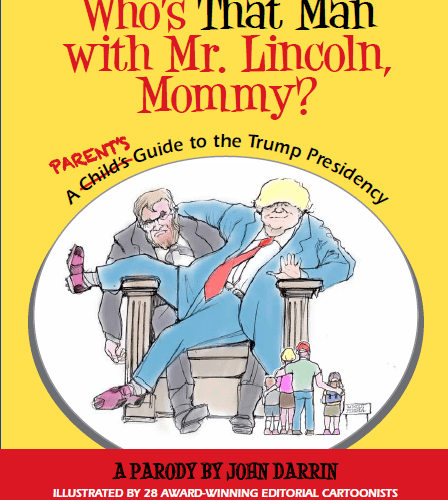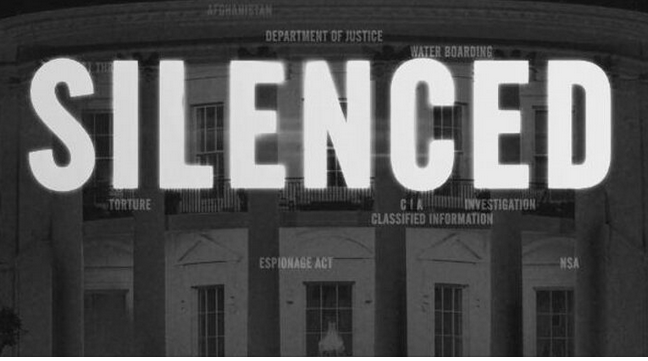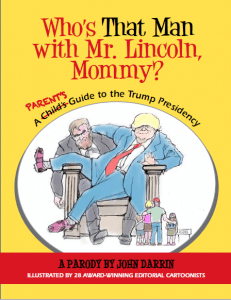 Taking the approach that it’s better to laugh at a despot than get angry at him, John Darrin roasts Trump and his administration in his new cartoon book, Who’s That Man With Mr. Lincoln, Mommy? With the help of 24 award-winning editorial cartoonists from news publications around the country, Darrin and company cut Trump down to size with their political insights and years of cartoon-drawing experience. Their humorous perspective pranks Trump in a series of editorial cartoons that a dozen tell-all books about his administration couldn’t match.
Taking the approach that it’s better to laugh at a despot than get angry at him, John Darrin roasts Trump and his administration in his new cartoon book, Who’s That Man With Mr. Lincoln, Mommy? With the help of 24 award-winning editorial cartoonists from news publications around the country, Darrin and company cut Trump down to size with their political insights and years of cartoon-drawing experience. Their humorous perspective pranks Trump in a series of editorial cartoons that a dozen tell-all books about his administration couldn’t match.
Darrin says he wrote the book as therapy to help him cope with the stress of Trump’s rise to power. “Humor and impact were the goals, and there is no better vehicle for that than a scathing editorial cartoon,” Darrin said.
Who’s That Man With Mr. Lincoln, Mommy? is a tour guide for making sense of the “neo unrealism” of Trumpian policy. The cartoons help children understand Trumpism, but they’re really drawn for adults.
The book portrays a conservative family on an alphabet tour through Washington, DC. As they explore the city of monuments, they discover the unrealities of Trumpism from A to Z. While the adults parentsplain, their clever children ask with innocent questions exposing the disconnect and hypocrisy in the world of Trump.
Cartoonists add wisdom gained from decades of hard knocks muck-raking. They outline the importance of cartooning as a tool to curb the egos of despots. Some of them even poke fun at their own editorial cartooning.
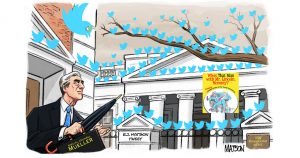
“The only thing necessary for triumph of evil is that good cartoonists draw nothing,” writes Robert Matson, bending a quote by Edmund Burke. An editorial cartoonist at Roll Call, he has decades of experience publishing cartoons in many top newspapers.
His cartoon depicts an unassuming caricature of Robert Mueller with a Sherlock Holmes-styled umbrella and satchel, looking skyward towards a long line of twitter birds outside the White House. This cartoon is a statement of how truth gets buried under propaganda while watchful eyes of intelligence know better.
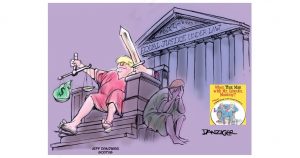
Jeff Danziger sketches an image of Trump’s influence on the Supreme Court. A metaphorical image of the Trump assimilation of the high seat of justice, it shows the president with the spoils of his Supreme Court takeover: money upsets the balance of justice after he manhandles Lady Justice out of her seat at the Supreme Court.
“An effective political cartoon should form an image in the reader’s mind that explains, provokes, convinces, cajoles, or simply entertains,” writes Danziger, who has been cartooning since 1975.
Then there’s Keith Knight, cartoonist of Knight Life. His cartoon depicts a caricature of Trump smugly tossing toilet tissue rolls at Puerto Rico. The issue of white privilege and race are unpacked in this gem of satire.
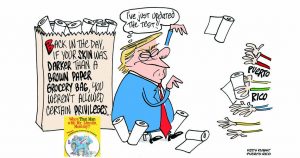
Barbara Dale sketched a picture of Trump with his heart missing. The cartoon involves a contentious issue of immigrants and the separation of families. “Editorial cartoonists are on the front line defending the First Amendment,” Dale writes.
Whether this book makes one laugh or shake their head in exasperation, it roots out Trump’s political gaffs, blunders and double-speak narratives, laying them bare to the funny bone.
Conservatives and progressives alike should keep this playbook handy as both a reprieve from current events and a historical reference. It’s a roadmap of how Trump pulled off one of the most improbable presidential upsets and democratic take-downs in electoral history.
Note: All images and quotes are used with the express permission of the author. Images may not be copied or reproduced without permission of the author.

